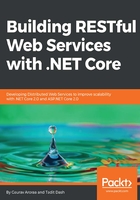
Conventions used
There are a number of text conventions used throughout this book.
CodeInText: Indicates code words in text, database table names, folder names, filenames, file extensions, pathnames, dummy URLs, user input, and Twitter handles. Here is an example: "The Header must appear as the first child of the envelope, before the body element."
A block of code is set as follows:
<?xml version = "1.0"?>
<SOAP-ENV:Envelope
xmlns:SOAP-ENV = "http://www.w3.org/2001/12/soap-envelope"
SOAP-ENV:encodingStyle = "http://www.w3.org/2001/12/soap-encoding">
...
SOAP Message information goes here
...
</SOAP-ENV:Envelope>
When we wish to draw your attention to a particular part of a code block, the relevant lines or items are set in bold:
{
// GET: api/Products
[HttpGet]
public IEnumerable<Product> Get()
{
return new Product[]
{
new Product(1, "Oats", new decimal(3.07)),
new Product(2, "Toothpaste", new decimal(10.89)),
new Product(3, "Television", new decimal(500.90))
};
}
}
Bold: Indicates a new term, an important word, or words that you see onscreen. For example, words in menus or dialog boxes appear in the text like this. Here is an example: "Simple Object Access Protocol (SOAP) is an XML-based messaging protocol for exchanging information among computers."
Warnings or important notes appear like this.
Tips and tricks appear like this.